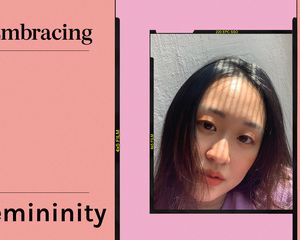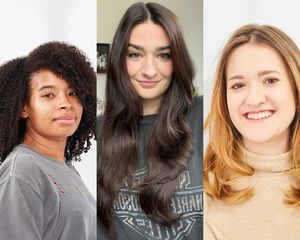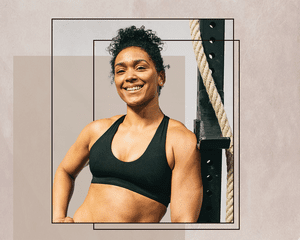Trigger warning: diet culture and disordered eating.
"If you do crunches in just your sports bra, seeing your stomach rolls might motivate you to do more reps."
No matter how hard I scrub, I can't seem to wipe that quote from my brain. It's one of many less-than-fond memories I hold from my childhood gymnastics coach. At the time, I was 15 and growing fast—growing hips, growing chest, and growing thighs that touched in the middle and made a clapping noise when I started sprinting ahead of a big tumble.
A late bloomer, I was thrilled to finally grow into an adult body—finally able to relate to my friends about things like stretch marks and period cramps. I was singing "Man, I Feel Like a Woman" in the shower and spending my babysitting money on cheap yoga pants that made me feel comfortable and celebrated in my new figure.
But to my coach, my new curves were like sandbags tied to my body—unnecessary weight that could tip me over the edge of the beam. Expectedly, after weeks of compressing my breasts with athletic tape (I was asked to do this) and wearing black leotards to "minimize" my figure, I turned against my own body.
I was never going to be an Olympic gymnast (or even a college gymnast), but I did end my career earlier than expected—and quitting gymnastics was just the beginning. I eventually quit every sport I was involved with (soccer, cheerleading, and even coaching my brother's little league team) because I couldn't stand the thought of people seeing my body—god forbid—change. Get bigger. Take up more space. Exist.
:max_bytes(200000):strip_icc()/fitness-embedded-horiz1-6063b5d489c0493184fb235d63430a8b.jpg)
@Hollyrhue/Design by Tiana Crispino
The only form of movement I didn't quit was movement I didn't enjoy. Exercise became a punishment for me. If I felt like I ate too much, I'd promptly put on black sweatpants, a black long-sleeve shirt, and run on the treadmill until I caved into boredom or exhaustion (whichever hit first). Sure, I looked "fit" because of all the running, but I left my workouts feeling miserable and weak—only satisfied if I finished my run feeling dizzy and starving. And I repeated this cycle for years—until the pandemic hit.
When the world—including my gym—shut down in March 2020, I started to have panic attacks about not being able to access a treadmill. (And as I now know, it wasn't about fear of not being able to exercise—it was fear of not being able to punish myself when I thought I over-indulged.) So I started streaming living room workouts on YouTube. Naturally, given my historic pattern with viewing exercise as punishment, I gravitated towards HIIT classes and push-up circuits. That's not to say there's anything wrong with those types of exercises—both are perfectly wonderful for your health and make so many people feel strong and powerful. But for me personally, I chose these videos because they made me feel like I was suffering. They were a way to "pay" for what I'd eaten earlier with a big calorie burn.
Then, something rather serendipitous took place during one of the darkest periods of our lifetime. Somewhere between the dalgona coffee era and Zoom happy hours, the world became obsessed with athlesiure. My feed was full of people wearing tie-dye sweatsuits and neon matching separates. So like any investigative editor, I got in on the trend.
My inaugural outfit was—no surprise—a tie-dye sweatsuit from Summersalt. From there, I bought hot pink and baby blue biker shorts from Set Active, leopard print leggings from Bandier, and square-cut sports bras from Full Court in every color of the rainbow—all a far cry from the black sweatsuits of my pre-pandemic life. While these prints and cuts are fun to wear, the impact that this minor change of wardrobe had on my workouts—and ultimately my mental health—is genuinely remarkable.
:max_bytes(200000):strip_icc()/NEW-embedded-vertcopycopy-37b7718baaa048d9a621900a28df3dbd.jpg)
Holly Rhue/Design by Tiana Crispino
It took some time, but from the privacy of my living room, I stopped feeling like I had to hide my body when I worked out. Instead, I wore my brand new pandemic athlesiure (things I'd never felt comfortable wearing publicly to the gym). And here's the thing—the joy of wearing clothing that made me feel bright and beautiful didn't align with the feeling of dread I'd associated with working out. Wearing color, wearing non-compressive fabrics that allowed my curves to exist, wearing outfits that felt like a reward instead of a punishment made me want to feel the same way about my movement.
As a result, I ditched the punishing HIIT workouts and made a promise to myself to find movement that I loved—movement that better fit the clothes that better fit me, who I am, and what I want my relationship with exercise to be. And consequently, when you feel amazing in what you're wearing and with the movement you're doing, your workouts improve.
There have been plenty of studies about how your clothing influences your performance (not just with fitness, but with work and your social life, too). One 2015 study found that students who dressed in formal clothing for an exam performed better than the group that was asked to wear casual clothing. Another 2012 study found that simply having someone put on a lab coat would increase their attentiveness during a lecture. What we wear influences our confidence, and our confidence influences our performance.
The same rang true for me. Simply swapping my workout clothes forced me to take a closer look at my relationship with exercise and ultimately pushed me to find something I loved as much as my new wardrobe. And after a bit of research, I discovered a body-positive fitness streaming platform. I don't do any HIIT classes anymore, because as an individual, I simply do not enjoy them. Instead, I do dance cardio, boxing, and Pilates classes because I love the way they make me feel.
Because I love these forms of movement, I get a more effective workout. I'm more deliberate about my form because I want to be good at this thing that I lenjoy, and I can go for longer because I'm having a good time. I leave my workouts feeling full, powerful, and colorful. I'm no longer obsessed with numbers on the scale or the "nutrient" (read: calorie) tracker on my phone. I'm getting the most important nutrient now: joy.
This morning, I wore a fire-engine red matching set. I'm 10 pounds heavier than my pre-pandemic weight, and I'm in the best shape of my life—physically and mentally.
:max_bytes(150000):strip_icc()/landingpage_hero_desktop-13147bc1d9fc4e9a8e4e6a323d6011b3.jpg)
:max_bytes(150000):strip_icc()/B-Sides_recirc-b7dee4e62cad4eaf8c19110ad6a6f3b4.jpg)
:max_bytes(150000):strip_icc()/edit_asian-beauty-noteables-recirc-67113c075a344ddcb74a9b88cff62807.jpg)
:max_bytes(150000):strip_icc()/therapytips-recircsprimary-a8b50ff82888487fb477b07cfc1dc784.jpg)
:max_bytes(150000):strip_icc()/compassionfatigue-recircsprimary-5222a3c16468416fae712fa7823b53a4.jpg)
:max_bytes(150000):strip_icc()/editorspick-recircs-13eb4e9f18ee413db9514e344d7a8968.jpg)
:max_bytes(200000):strip_icc()/exclsuivecopy1-46445f78ae944891af1d7ed94e805cc2.jpg)



